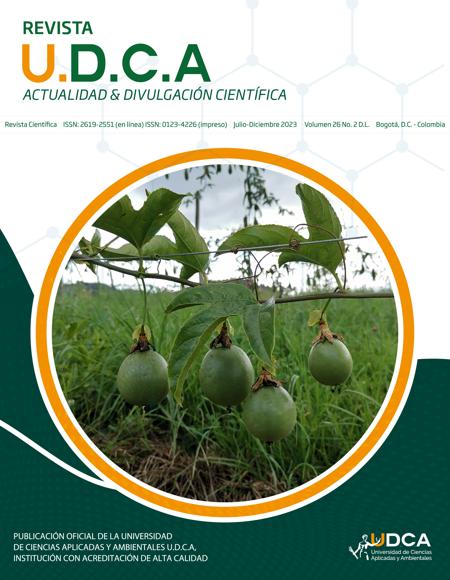Capacidad antibacteriana de la leche y el calostro bovino, caprino, bufalino y humano, contra bacterias de importancia clínica
Antibacterial capacity of bovine, goat, buffalo and human milk and colostrum, against bacteria of clinical importance in animal and human health
Contenido principal del artículo
Resumen
La leche y el calostro materno de diversas especies es un fluido corporal con efectos benéficos para la salud de quien la recibe, debido a que es la primera línea de defensa, favoreciendo el desarrollo, el crecimiento y la protección del recién nacido. Su actividad antibacteriana frente a patógenos de importancia clínica, la sugieren como una atractiva alternativa terapéutica ante la creciente resistencia bacteriana, que enfrenta la medicina animal y humana. Este trabajo comparó el efecto antimicrobiano de muestras de leche madura y calostro de especies bovina, caprina, bufalina y humana. Se realizaron siembras masivas con cepas ATCC de Pseudomonas aeruginosa, Klebsiella pneumoniae, Staphylococcus aureus y Escherichia coli en Mueller-Hinton; las muestras de leche y de calostro fueron diluidas en agua peptonada y colocadas en las cajas, utilizando sensidiscos estériles, impregnados con diferentes diluciones; se incubaron y posteriormente se midió el halo de inhibición alrededor de los sensidiscos, indicando su capacidad antimicrobiana. Se demostró poca actividad antibacteriana de la leche vs el calostro; a su vez, se evidenció que la leche y el calostro humano, caprino y bufalino mostraron actividad antibacteriana contra P. aeruginosa; solo el calostro humano, caprino y bufalino mostraron actividad frente a K. pneumoniae. Los resultados obtenidos permitieron demostrar que la leche y el calostro tienen efectos antimicrobianos.
Palabras clave:
Descargas
Datos de publicación
Perfil evaluadores/as N/D
Declaraciones de autoría
- Sociedad académica
- Universidad de Ciencias Aplicadas UDCA
- Editorial
- Universidad de Ciencias Aplicadas y Ambientales U.D.C.A
Detalles del artículo
Referencias (VER)
BORAD, S.G.; SINGH, A.K. 2018. Colostrum immunoglobulins: Processing, preservation and application aspects. International Dairy Journal. 85:201-210. https://doi.org/10.1016/j.idairyj.2018.05.016 DOI: https://doi.org/10.1016/j.idairyj.2018.05.016
CHEGINI, Z.; KHOSHBAYAN, A.; MOGHADAM, M.T.; FARAHANI, I.; JAZIREIAN, P.; SHARIATI, A. 2020. Bacteriophage therapy against Pseudomonas aeruginosa biofilms: A review. Annals of Clinical Microbiology and Antimicrobials. 19:45. https://doi.org/10.1186/S12941-020-00389-5 DOI: https://doi.org/10.1186/s12941-020-00389-5
CONTE, F.; SCARANTINO, S. 2013. A study on the quality of bovine colostrum: physical, chemical and safety assessment. International Food Research Journal. 20(2):925-931.
DIGGLE, S.P.; WHITELEY, M. 2020. Microbe profile: Pseudomonas aeruginosa: opportunistic pathogen and lab rat. Microbiology. 166(1):30. https://doi.org/10.1099/MIC.0.000860 DOI: https://doi.org/10.1099/mic.0.000860
DING, C.; JIANZHONG, H. 2010. Effect of antibiotics in the environment on microbial populations. Applied Microbiology and Biotechnology. 87(3):925-41. https://doi.org/10.1007/s00253-010-2649-5 DOI: https://doi.org/10.1007/s00253-010-2649-5
DZIK, S.; MICIŃSKI, B.; AITZHANOVA, I.; MICIŃSKI, J.; POGORZELSKA, P.; BEISENOV, A.; KOWALSKI, I.M. 2017. Properties of bovine colostrum and the possibilities of use. Polish Annals of Medicine. 24(2):295–99. https://doi.org/10.1016/j.poamed.2017.03.004 DOI: https://doi.org/10.1016/j.poamed.2017.03.004
FASSE, S.; ALARINTA, J.; FRAHM, B.; WIRTANEN, G. 2021. Bovine colostrum for human consumption-improving microbial quality and maintaining bioactive characteristics through processing. Dairy. 2(4):556-575. https://doi.org/10.3390/DAIRY2040044 DOI: https://doi.org/10.3390/dairy2040044
FOUNOU, L.L.; FONOU, R.C.; ESSACK, S.Y. 2016. Antibiotic resistance in the food chain: A developing country-perspective. Frontiers in Microbiology. 7:1881. https://doi.org/10.3389/fmicb.2016.01881 DOI: https://doi.org/10.3389/fmicb.2016.01881
FRIERI, M.; KUMAR, K.; BOUTIN, A. 2017. Antibiotic resistance. Journal of Infection and Public Health. 10(4):369-78. https://doi.org/10.1016/J.JIPH.2016.08.007 DOI: https://doi.org/10.1016/j.jiph.2016.08.007
GAO, X.; LI, Y.; OLIN, A.B.; NGUYEN, D.C. 2020. Fortification with bovine colostrum enhances antibacterial activity of human milk. Journal of Parenteral and Enteral Nutrition. 45(7):1417-1424. https://doi.org/10.1002/jpen.2060 DOI: https://doi.org/10.1002/jpen.2060
INFECTIOUS DISEASES SOCIETY OF AMERICA, IDSA. 2018. Infectious diseases society of America (IDSA) POSITION STATEMENT: Why IDSA did not endorse the surviving sepsis campaign guidelines. Clinical Infectious Diseases. 66(10):1631-1635. https://doi.org/10.1093/cid/cix997 DOI: https://doi.org/10.1093/cid/cix997
JARRIGE, N.; CAZEAU, G.; BOSQUET, G.; BASTIEN, F.; BENOIT, F.; GAY, E. 2020. Effects of antimicrobial exposure on the antimicrobial resistance of Escherichia coli in the digestive flora of dairy calves. Preventive Veterinary Medicine. 185:105177. https://doi.org/10.1016/j.prevetmed.2020.105177 DOI: https://doi.org/10.1016/j.prevetmed.2020.105177
MCGRATH, B.A.; FOX, P.F.; MCSWEENEY, P.L.H.; KELLY, A.L. 2015. Composition and properties of bovine colostrum: A review. Dairy Science & Technology. 96(2):133-158. https://doi.org/10.1007/S13594-015-0258-X DOI: https://doi.org/10.1007/s13594-015-0258-x
MEEKER, D.G.; JENKINS, S.V.; MILLER, E.K.; BEENKEN, K.E.; LOUGHRAN, A.J.; POWLESS, A.; MULDOON, T.J.; GALANZHA, E.I.; ZHARO, V.P.; SMELTZER, M.S.; CHEN, J. 2016. Synergistic photothermal and antibiotic killing of biofilm-Associated Staphylococcus aureus using targeted antibiotic-loaded gold nanoconstructs. ACS infectious diseases. 2:241-250. https://doi.org/10.1021/acsinfecdis.5b00117 DOI: https://doi.org/10.1021/acsinfecdis.5b00117
MOHANTY, D.; JENA, R.; CHOUDHURY, P.K.; PATTNAIK, R.; MOHAPATRA, S.; SAINI, M.R. 2016. Milk derived antimicrobial bioactive peptides: a review. International Journal of Food Properties. 19(4):837-846. https://doi.org/10.1080/10942912.2015.1048356 DOI: https://doi.org/10.1080/10942912.2015.1048356
MUNITA, J.; ARIAS, C.A. 2016. Mechanisms of antibiotic resistance. Microbiology Spectrum. 23(5):464-72. https://doi.org/10.1128/MICROBIOLSPEC.VMBF-0016-2015 DOI: https://doi.org/10.1128/microbiolspec.VMBF-0016-2015
NOLAN, L.S.; PARKS, O.B.; GOOD, M. 2019. A Review of the immunomodulating components of maternal breast milk and protection against necrotizing enterocolitis. Nutrients. 12(1):14. https://doi.org/10.3390/NU12010014 DOI: https://doi.org/10.3390/nu12010014
PANDEY, N.; DAR, A.; MONDAL, D.B.; NAGARAJA, L. 2011. Bovine colostrum: A veterinary nutraceutical. Journal of Veterinary Medicine and Animal Health. 3(3):31-35.
PATINI, R.; MANGINO, G.; MARTELLACCI, L.; QUARANTA, G.; MASUCCI, L.; GALLENZI, P. 2020. The effect of different antibiotic regimens on bacterial resistance: A systematic review. Antibiotics. 9(1):22. https://doi.org/10.3390/antibiotics9010022 DOI: https://doi.org/10.3390/antibiotics9010022
PIOTROWSKI, M.; WULTAŃSKA, D.; PITUCH, H. 2021. The prebiotic effect of human milk oligosaccharides 3’- and 6’-sialyllactose on adhesion and biofilm formation by Clostridioides difficile - Pilot study. Microbes and Infection. 24(3):104929. https://doi.org/10.1016/J.MICINF.2021.104929 DOI: https://doi.org/10.1016/j.micinf.2021.104929
RASCÓN-CRUZ, Q.; ESPINOZA-SÁNCHEZ, E.A.; SIQUEIROS-CENDÓN, T.S.; NAKAMURA-BECOMO, S.I.; AREVALO-GALLEGO, S.; IGLESIAS-FIGUEROA, B.F. 2021. Lactoferrin: A glycoprotein involved in immunomodulation, anticancer, and antimicrobial processes. Molecules. 26(1):205. https://doi.org/10.3390/MOLECULES26010205 DOI: https://doi.org/10.3390/molecules26010205
RAY, C.; KERKETTA, J.A.; RAO, S.; PATEL, S.; DUTT, S.; ARORA, K.; POURNAMI, F.; BHUSHAN, P. 2019. Human milk oligosaccharides: the journey ahead. International Journal of Pediatrics. 2019:2390240. https://doi.org/10.1155/2019/2390240 DOI: https://doi.org/10.1155/2019/2390240
RELLO, J.; BUNSOW, E.; PEREZ, A. 2016. What if there were no new antibiotics? A Look at Alternatives. Expert Review of Clinical Pharmacology. 9(12):1547-55. https://doi.org/10.1080/17512433.2016.1241141 DOI: https://doi.org/10.1080/17512433.2016.1241141
RUIZ-DIAZ, M.; ARGÜELLO, A.; PADILLA, D.; EARLEY, B.; CASTRO, N. 2019. Influence of treatment and refrigeration time on antimicrobial activity of goat and sheep colostrum. Journal of Dairy Research. 86(4):450-453. https://doi.org/10.1017/S0022029919000657 DOI: https://doi.org/10.1017/S0022029919000657
SEARS, K.T.; TENNANT, S.M.; REYMANN, M.K.; SIMON, R.; KONSTANTOPOULOS, N.; BLACKWELDER, W.C.; BARRY, E.M.; PASETTI, M.F. 2017. Bioactive immune components of anti-diarrheagenic enterotoxigenic Escherichia coli hyperimmune bovine colostrum products. Clinical and Vaccine Immunology. 24(8):e00186-00116. https://doi.org/10.1128/CVI.00186-16 DOI: https://doi.org/10.1128/CVI.00186-16
SILVA, E.; RANGEL, A.; MÜRMAM, L.; BEZERRA, M.; OLIVEIRA, J. 2019. Bovine colostrum: benefits of its use in human food. Food Science and Technology: 39:355-362. https://doi.org/10.1590/fst.14619 DOI: https://doi.org/10.1590/fst.14619
SRIVASTAVA, A.; SINGH, B.N.; DEEPAK, D.; RAWAT, A.K.; SINGH, B. 2015. Colostrum hexasaccharide, a novel Staphylococcus aureus quorum-sensing inhibitor. Antimicrobial agents and chemotherapy. 59(4):2169-2178. https://doi.org/10.1128/AAC.03722-14 DOI: https://doi.org/10.1128/AAC.03722-14
TOSCANO, M.; DE GRANDI, R.; PERONI, D.G.; GROSSI, E.; FACCHIN, V.; COMBERIATI, P.; DRAGO, L. 2017. Impact of delivery mode on the colostrum microbiota composition. BMC microbiology. 17:205. https://doi.org/10.1186/s12866-017-1109-0 DOI: https://doi.org/10.1186/s12866-017-1109-0
TRIPATHI, V.; VASHISHTHA, B. 2006. Bioactive compounds of colostrum and its application. Food Reviews International. 22(3):225-244. https://doi.org/10.1080/87559120600694606 DOI: https://doi.org/10.1080/87559120600694606
ULFMAN, L.H.; LEUSEN, J.H.W.; SAVELKOUL, H.F.J.; WARNER, J.O.; VAN NEERVEN, R.J.J. 2018. Effects of bovine immunoglobulins on immune function, allergy, and infection. Frontiers in nutrition. 5:52. https://doi.org/10.3389/fnut.2018.00052 DOI: https://doi.org/10.3389/fnut.2018.00052
VEGA, C.G.; BOK, M.; EBINGER, M.; ROCHA, L.A.; RIVOLTA, A.A.; GONZÁLEZ THOMAS, V.; MUNTADAS, P.; D’ALOIA, R.; PINTO, V.; PARREÑO, V.; WIGDOROVITZ, A. 2020. A new passive immune strategy based on IgY antibodies as a key element to control neonatal calf diarrhea in dairy farms. BMC Veterinary Research. 16(1):264. https://doi.org/10.1186/s12917-020-02476-3 DOI: https://doi.org/10.1186/s12917-020-02476-3
VENTOLA, L.C. 2015. The antibiotic resistance crisis: Part 1: causes and threats. Pharmacy and Therapeutics. 40(4):277-83.
VENTOLA, L.C. 2015. The antibiotic resistance crisis: Part 2: Management strategies and new agents. Pharmacy and Therapeutics. 40(5):344-52.
VILLAMIL, R.A.; ROBELTO, G.E.; MENDOZA, M.C.; GUZMÁN, M.P.; CORTÉS, L.Y.; MÉNDEZ, C.A.; GIHA, V. 2020. Desarrollo de productos lácteos funcionales y sus Implicaciones en la salud. Una revisión de literatura. Revista Chilena de Nutrición 47(6):1018–1028. https://doi.org/10.4067/S0717-75182020000601018 DOI: https://doi.org/10.4067/S0717-75182020000601018
WINDAYANI, N.; KURNIATI, T.; RUKAYADI, Y. 2020. Antibacterial activity of colostrum kefir against foodborne pathogen bacteria. IOP Conference Series: Earth and Environmental Science. 472:012019. https://doi.org/10.1088/1755-1315/472/1/012019 DOI: https://doi.org/10.1088/1755-1315/472/1/012019
YVON, S.; OLIER, M.; LEVEQUE, M.; JARD, G.; TORMO, H.; HAIMOUD-LEKHAL, D.A.; PETER, M.; EUTAMÈNE, H. 2018. Donkey milk consumption exerts anti-inflammatory properties by normalizing antimicrobial peptides levels in Paneth’s cells in a model of ileitis in mice. European Journal of Nutrition. 57(1):155-166. https://doi.org/10.1007/s00394-016-1304-z DOI: https://doi.org/10.1007/s00394-016-1304-z
ZHANG, F.; CUI, X.; FU, Y.; ZHANG, J.; ZHOU, Y.; SUN, Y.; WANG, X.; LI, Y.; LIU, Q.; CHEN, T. 2017. Antimicrobial activity and mechanism of the human milk-sourced peptide Casein201. Biochemical and biophysical research communications. 485(3):698-704. https://doi.org/10.1016/j.bbrc.2017.02.108 DOI: https://doi.org/10.1016/j.bbrc.2017.02.108
ZINGER-YOSOVICH, K.D.; ILUZ, D.; SUDAKEVITZ, D.; GILBOA-GARBER, N. 2010. Blocking of Pseudomonas aeruginosa and Chromobacterium violaceum lectins by diverse mammalian milks. Journal of dairy science. 93(2):473-482. https://doi.org/10.3168/jds.2009-2381 DOI: https://doi.org/10.3168/jds.2009-2381







